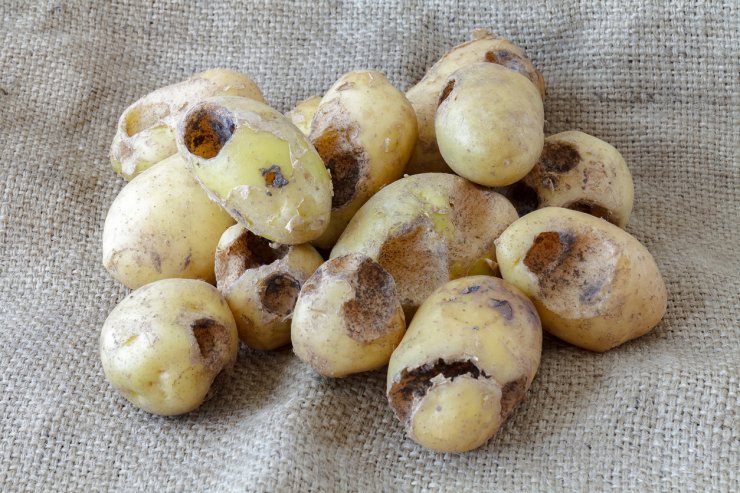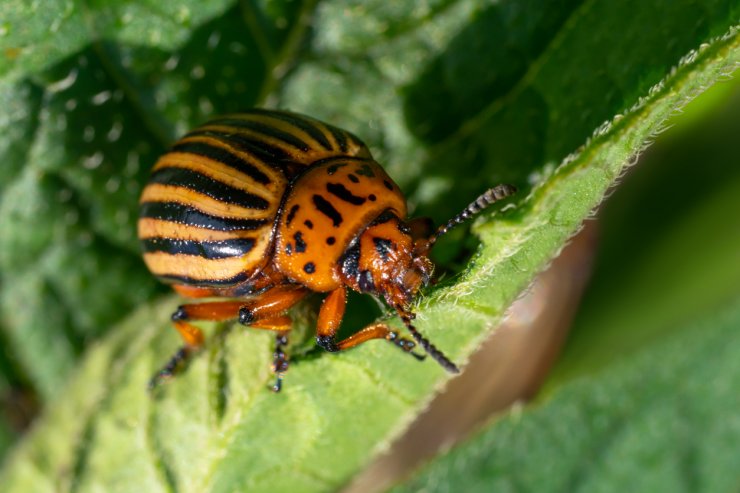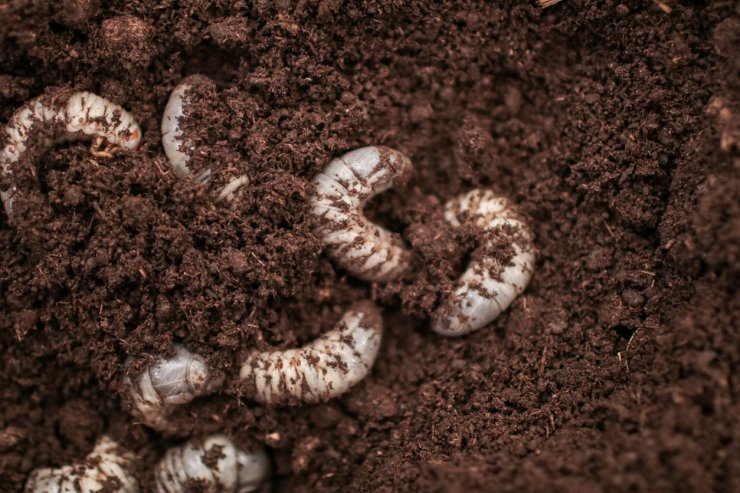
Potatoes eaten by pests.
Common Potato Pests

A Colorado potato beetle
Stay vigilant for the presence of pests on your potatoes. With a home potato garden, pesticide use is overkill (so to speak); it’s more productive for you to visually inspect your plants for pests, and to plan regular crop rotation with your nitrogen-fixing friends, the legumes, which will help make your potato plants stronger.
The best approach to protecting your potatoes is to spot the pests and pick them off, one by one. Colorado potato beetles and aphids are common potato pests. Other pests include the cutworm, which can chew holes in your plants; and white grubs and wireworms, which drill into potato seed pieces and tubers.
If picking the pests off is not enough, you can use insecticides or insecticidal soaps. Talk to your local garden or extension center for other recommendations.
Common Sweet Potato Pests

Sweet potato weevil larvae
The sweet potato varieties that grow in the U.S. tend to be less susceptible to pests than varieties in other parts of the world. However, you should still keep an eye out for a few pests that can cause some serious damage.
Sweet potato weevils damage the vines and leaves of the plant. Adult weevils can bore into the roots. Roots in which weevils have deposited eggs are doomed: the roots respond by producing toxic terpenes, rendering the sweet potato inedible. There’s no cure for a weevil infestation. Crop rotation can help, as can hilling up the soil around the base of the plants. Ants and spiders are natural enemies of the weevil, so pay attention to your local ecosystem; support your local spider!
Aphids suck the sap from growing plant shoots, moving from plant to plant and transmitting viruses. You’ll notice the leaves of your young plant wrinkling if aphids are in the area. The best solution to aphids? Ladybugs. They just eat aphids up. Try to avoid using insecticides, since they can damage beneficial insects and open the door for more aphid infestations.
Your best bet to have pest-resistant plants is to acquire your seeds and slips from a reputable source. And once things get growing, get out there with your garden gloves on and pick those pesky pests off—or send them packing with a blast from your garden hose. Just don’t over-water your crops.
Do pests attack your potato and sweet potato plants? How do you handle removing them—or preventing them in the first place? Please tell us how you deal with pests preying on your potato and sweet potato plants.


 Previous
Previous


What about White Flies! They are abundant on my plants. I’m using Neem Oil spray in the morning, this will be my second spray (every 7 days). I hope this works. These were surprise potatoes from when I dug vegetable scraps from my kitchen in my garden over the winter. I’d love to have some of these but this doesn’t look good.
How do you get rid of wire worms?
Great question Norman. As you may know, wire worms aren’t actually related to our friend, the earth worm. Wire worms are the larvae of beetles and can cause a whole lot of trouble to your potato crop as well as other root vegetables.
Some natural solutions you could try are crop rotation and solarization to heat up the soil and dry it out. You might also consider creating some bait traps by digging several small holes in your garden and filling them with carrots, freshly cut seed potato pieces, or a mixture of soaked seeds, such as wheat and oats. Cover the holes and adjacent soil with a piece of black plastic. In four or five days examine the baited holes to determine if wireworms are present and manually dispose them.
There may be some soil-applied or seed treatment insecticides that can help control wireworm infestation, however, I would contact your local county Cooperative Extension office for a list of recommended insecticides that are appropriate for home gardens in your area.
Good luck and let us know what you try and how it works!
Thank you Norann. We will try the bait method and I was also thinking of putting a clear plastic roof over the soil boxes to heat up the soil and keep the rain off it until planting time. It is very wet up here right now. Also our soil is not very loose, so I was going to add more peat moss to it. Any thoughts on this? Thank you.
Norman – we have a great article on soil solarization. This can be an effective method for getting rid of pests but it takes time (several weeks) and may delay or interfere with this year’s gardening plans.
https://foodgardening.mequoda.com/daily/pests-diseases/reasons-to-try-soil-solarization-this-year-and-reasons-not-to/
As for peat – it does a great job loosening your soil but it can also retain water. You might try adding a combination of peat and some other organic materials like compost, chemical-free grass clippings and shredded leaves.